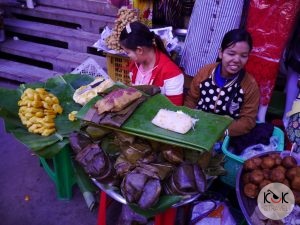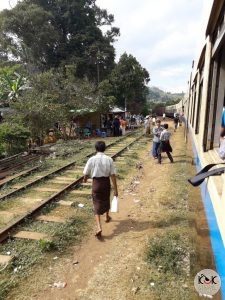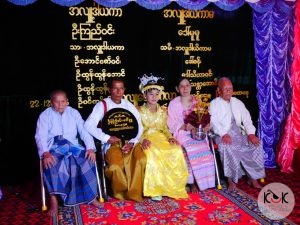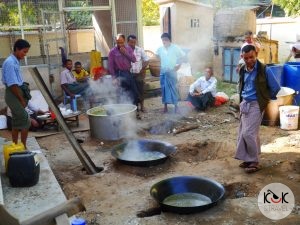
Certain rules, habits and behavior of people are similiar in different Asian countries. There are some characteristic features linking Thailand, Cambodia, Vietnam and Indonesia, because these countries are similar especially in terms of their attitude towards tourists and, unfortunately, with a common approach, that a white tourist should pay for everything because it’s a walking ATM. Myanmar can not be called a typical Asian country, although there are a lot of conmen as well, but it certainly can not be pigeonholed into the same category as the above-mentioned countries. Myanmar is different not only because of its political situation (being a sanctioned country under the regime of the military junta), but mostly because of the people, their incredible hospitality and delicious cuisine.

Here is what we found unusual about Myanmar:
1.If you put in a row women from different Asian countries, the first one you would easily recognize is the one coming from Myanmar. Women in this country put on their faces a yellow-white powder from the bark of the Thanaka tree mixed with water, which after drying provides protection against the sun, mosquitoes, prevents from wrinkles (so theoretically extends youth) and helps bleach the skin. Mothers put ‘Thanaka’ also on their children’s faces. 90% of women in this country have this ‘ointment’ on their faces.




 2.Most of men wear ‘longyi’ instead of trousers which look like longer skirts. They are in different colours and designs and are manufactured in Amarapura near Mandalay.
2.Most of men wear ‘longyi’ instead of trousers which look like longer skirts. They are in different colours and designs and are manufactured in Amarapura near Mandalay.
 3.Burmese drivers drive on the right side of the road, and what’s weird, they have the steering wheel also on the right side in their cars….! Why? One of the drivers explained to us that around 50 years ago after the British colonial times Burmese military government decided to change the driving rule and make people drive on the right side. So they changed the sides but the steering wheels remained as they were! How do they drive then? Due to insufficient visibility on the road (they do not use mirrors) they use the horn all the time.
3.Burmese drivers drive on the right side of the road, and what’s weird, they have the steering wheel also on the right side in their cars….! Why? One of the drivers explained to us that around 50 years ago after the British colonial times Burmese military government decided to change the driving rule and make people drive on the right side. So they changed the sides but the steering wheels remained as they were! How do they drive then? Due to insufficient visibility on the road (they do not use mirrors) they use the horn all the time.
4.Practically anywhere in Asia you will meet the famous shop branch: 7 Eleven. Well, not in Myanmar, and in some places like: Mandalay, Hsipaw you will not buy everything in a local supermarket. Example? In Mandalay when we entered some supermarkets or local shops and bought some whiskey (or any alcohol) it was not possible to buy big bottles of Coke (they had soft drinks in small cans only), and the other way round, where you got soft drinks in big bottles you couldn’t get alcohol and, moreover, the big bottles were kept on warm shelves in the store, especially in Mandalay and Hsipaw, because their refrigerators had smaller shelves and big bottles couldn’t fit there. Towns near Inle Lake are more developed regarding this, and of course, Yangon is a totally different world, there you can find a lot of well-equipped supermarkets – but don’t expect you can pay by Visa card there, out of 6 supermarkets we went to, only 1 had this payment method.
5.You are in a night bus, and the journey is to last 11h, and here a surprise – you reach your destination in 8h, and it turns out that it is still night, time: 3:30am. You have your stay booked for the next day, you get to the hostel / hotel, the service at the reception kindly welcomes you and invites you to your room (you sleep there half a night for free!). Example? Joy Hotel in Nyuang Shwe at the Inle Lake and Everest Hotel in Yangon. In Bagan Nyaung-U in Ever New Guesthouse all rooms were occupied, so we were offered dozing off in an additional room for 8 people (a kind of overnight waiting room with beds) and provided blankets, pillows and were invited to have breakfast for free. This is what the true hospitality means!
6.If you come across a celebration in a village (as we did in New Bagan where there was a noviceation ceremony preparing young boys to go to monastery as novices before becoming monks), the village people will invite you to eat with them for free (and they serve a soup from a huge pot). What’s more, if the food disappears from the plates, the service approaches you and asks if you want more soup, rice, salad, etc. Here’s what we got:






 7.Practically nowhere in Asia you will pay for the local food as little as in Myanmar. We thought that Cambodia beats all the Asian countries with dishes for 1USD, but that’s the past. In Myanmar we paid for a local soup in the street less than 0.20USD! You can eat a huge vegetarian pancake which is cut for 2 portions each for 1 person for 0.30USD or rice with chicken, to which you will get the following ingredients for free: fresh vegetables (lettuce, carrot, cucumber), sauces, soup and tea, all for 1000 -1500MMK (0.75-1.20USD)! Burmese cuisine is delicious, you can see that the people there know how to make dishes spicy enough, they know also the Indian and Thai cuisine, but would happily share their culinary traditions (anyway it’s good to sign up for a cooking class to see and feel the Burmese rustic culinary habits, starting from the selection of products on the market and later preparing their dishes under the watchful eye of a local housekeeper).
7.Practically nowhere in Asia you will pay for the local food as little as in Myanmar. We thought that Cambodia beats all the Asian countries with dishes for 1USD, but that’s the past. In Myanmar we paid for a local soup in the street less than 0.20USD! You can eat a huge vegetarian pancake which is cut for 2 portions each for 1 person for 0.30USD or rice with chicken, to which you will get the following ingredients for free: fresh vegetables (lettuce, carrot, cucumber), sauces, soup and tea, all for 1000 -1500MMK (0.75-1.20USD)! Burmese cuisine is delicious, you can see that the people there know how to make dishes spicy enough, they know also the Indian and Thai cuisine, but would happily share their culinary traditions (anyway it’s good to sign up for a cooking class to see and feel the Burmese rustic culinary habits, starting from the selection of products on the market and later preparing their dishes under the watchful eye of a local housekeeper).
8.Great choice of vegetarian dishes in Myanmar – it really is a paradise for vegetarians! We are carnivores, but we have to admit that tasting vege snacks and meals in this country appealed to us. Here are some suggestions:







 9. In Myanmar you will not find the cheapest type of accommodation: dormitory rooms. We should give this country a little more time. Therefore, you will not sleep in dorms for 5USD as e.g. in Thailand, you can have your private room only but breakfast is included everywhere without any exceptions. We managed to fit in the price: 9USD per night per person in hotels and guesthouses and this was in the downtown, not in the outskirts of cities.
9. In Myanmar you will not find the cheapest type of accommodation: dormitory rooms. We should give this country a little more time. Therefore, you will not sleep in dorms for 5USD as e.g. in Thailand, you can have your private room only but breakfast is included everywhere without any exceptions. We managed to fit in the price: 9USD per night per person in hotels and guesthouses and this was in the downtown, not in the outskirts of cities.
Looking at the negative aspects prevailing in this beautiful country, the following should be mentioned:
- The poverty in Myanmar strikes more than in other Asian countries. There is a huge discrepancy between the quality of life there and golden temples built to cherish Buddha… It’s really unbelievable. Moreover, people are not aware of the reality outside their own country, what is happening in the world beyond the borders of Myanmar (the military regime imposes many limitations there).








- Up to these days tourists aren’t permitted to travel everywhere in Myanmar, and their stay in the country is strictly controlled, so you’d better check such information before planning to go to distant areas. The citizens do not hide the fact that the government deliberately limits the access for the tourists to remote corners of the country. Why? Because these are the poorest places in Myanmar – so the tourists cannot be allowed to see such a misery. In Hsipaw our trekking tour was cancelled, as we were informed that there was an outbreak of a military dispute in mountainous areas and for the sake of safety we were discouraged to go there. Even when in Mandalay taking a standard shorter way by walk to Mandalay Palace trying to get to a closer entrance we were not permitted to enter the gate as according to the military officials it led through a military base and we were redirected to get to the opposite side with the entrance where the tourists were permitted to enter. Everything would be ok if not for the fact that you had to walk more than 3km to get there, so we were immediately asked by one official if we did not need a taxi there, the guy was probably thinking that foreigners are too lazy to walk those 3 km – you should have seen his face as we politely refused and said that we would have a walk in that scorching sun.
- In many places labelled as ‘must see’ in Myanmar such as Bagan (under UNESCO World Heritage) and Inle Lake the foreigners must pay a special fee upon etering these zones: respectively 25.000MMK (18USD) and 12,500 / 10USD, the locals entering the same zones do not pay literally anything. In other Asian countries, the locals pay some entrance fees, they do not pay much but they are charged as well.
- A poor Wi-Fi connection was a real disadvantage for us as bloggers. If you need the Internet access, we recommend you buying the Internet package at the airport for 7,400MMK/ 5.50USD (the price for the activation packet of 2GB Internet per month).
We hope that the disadvantages presented haven’t overshadowed the advantages of the uniqueness of this country. It is worth noting that in Myanmar it’s super-cheap and interesting to explore wilder areas on a bike (prices range from 1.500MMK/ 1.10USD at Inle Lake to 2.500-3.000MMK /1.75-2.20USD in Hsipaw for an all day rental). So sometimes it doesn’t make any sense to overpay for a guide as at the reception in a hotel you will get a map of the region and tips on how to get to some places on your own J





